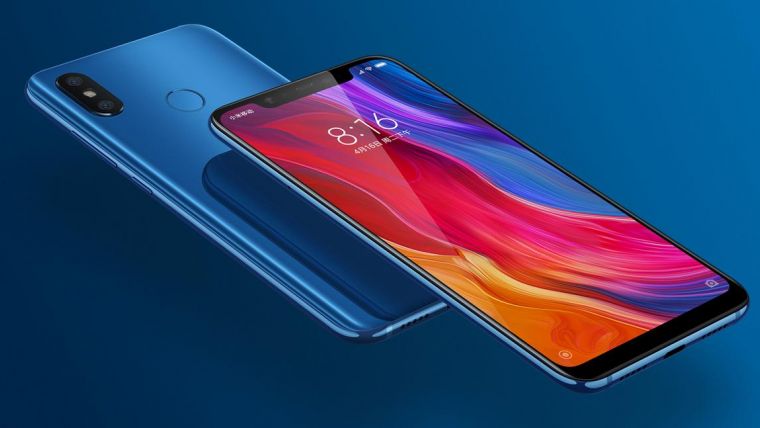World’s First Dual-frequency GNSS Smartphone Launched
Xiaomi, a fast-growing Chinese mobile phone giant headquartered in Beijing, has introduced the world’s first dual-frequency GNSS smartphone. Fitted with a Broadcom BCM47755 chip, the Xiaomi Mi 8, officially launched on 31 May, is the world’s first smartphone providing up to decimetre-level accuracy for location-based services and vehicle navigation.
Xiaomi has launched the world’s first dual-frequency GNSS smartphone, the Mi 8. This smartphone represents a breakthrough in GNSS technology as it is the first commercial deployment of Broadcom’s revolutionary BCM47755 chip.
The BCM47755, introduced last year, is a dual-frequency (E1/L1+E5/L5) GNSS chip that can compute location with an accuracy of up to a few decimetres. Until now, mobile location-based applications have been powered by single frequency GNSS receivers whose location accuracy is limited to a few meters. However, in recent years GNSS systems have been launching satellites broadcasting signals on new frequencies to open up new possibilities. Specifically, Galileo has the majority of satellites with E1/L1 and E5/L5 frequency capabilities.
Leveraging Galileo for increased accuracy
Users of the Xiaomi Mi 8 and future models with dual-frequency GNSS will benefit from better positioning and navigation experience in urban environments. This is due to the unique shape of the E5/L5 frequency, which makes it easier to distinguish real signals from the ones reflected by buildings, reducing the multipath effect (a major source of navigation error in cities and other challenging environments). The numerous Galileo satellites broadcasting E5 make this improvement available for users all around the world. In addition, the simultaneous use of two frequencies reduces other sources of error, such as those due to the ionosphere, and the frequency diversity is more robust to interference and jamming.
In addition to making existing applications more accurate, the enhanced position precision offered by dual-frequency GNSS will also create opportunities for new applications in areas such as augmented reality, vehicle navigation, and mapping.
Commenting on the product launch, European GNSS Agency (GSA) head of market development Gian Gherardo Calini said that the arrival of the first dual-frequency GNSS smartphone to the mass-market represents a breakthrough for users all over the world. The enhanced accuracy provided will empower developers to create new applications that meet the growing high accuracy location requirements of users and also open up applications that previously only ran in dedicated devices intended for professional use, he added.
High-level smartphone GNSS navigation
Alex Chou, vice president of product marketing for the Wireless Communications and Connectivity division at Broadcom, said his company is glad to gear up Xiaomi’s flagship smartphones with the very latest dual-frequency GNSS technology. Xiaomi Mi 8, the world’s first smartphone with BCM47755, will take smartphone GNSS navigation to a whole new performance level.
Zhiyuan Zang, director of product marketing from Xiaomi, said the importance of GNSS to modern life is undisputed, and is particularly important for smartphones. Navigation and LBS-based apps these days require greater positioning accuracy to work effectively, and dual-frequency GNSS is the key to delivering a great user experience when using these apps. Xiaomi is delighted and honoured to be the world's first smartphone manufacturer to support dual-frequency GNSS. They will continue to pursue innovation for everyone to enjoy, Zang added.
Exciting times for geolocation
The launch of the first dual-frequency GNSS smartphone, together with the opportunities offered by the availability of GNSS raw measurements in Android, creates exciting opportunities for the geolocation community. Access to raw measurements opens the door to algorithms once restricted to more advanced GNSS receivers. This, in turn, allows users to fully benefit from the differentiators offered by Galileo.
Recognising these opportunities, last year, the GSA engaged with the academia and industry in the areas of navigation and positioning to innovate around this new feature, as part of a GNSS Raw Measurements Task Force. Then, in January this year, the GSA published a White Paper on the use of GNSS Raw Measurements in Android, providing developers with in-depth information on accessing and using raw measurements to implement advanced GNSS techniques in mass-market devices.
Building on this work, the GSA and the Raw Measurements Taskforce shared their latest updates at a dedicated workshop – “GNSS Raw Measurements: From Research to Commercial Use” – held at the GSA headquarters in Prague on 30 May, where Broadcom presented their encouraging test results from the dual-frequency BCM47755.
Source: European GNSS Agency (GSA) is acknowledged as the source at the top or the bottom of the story. Visit the GSA website (http://www.gsa.europa.eu) to learn more.

Value staying current with geomatics?
Stay on the map with our expertly curated newsletters.
We provide educational insights, industry updates, and inspiring stories to help you learn, grow, and reach your full potential in your field. Don't miss out - subscribe today and ensure you're always informed, educated, and inspired.
Choose your newsletter(s)












